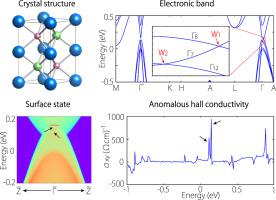Materials Today Physics ( IF 10.0 ) Pub Date : 2021-11-17 , DOI: 10.1016/j.mtphys.2021.100570 Yongheng Ge 1 , Yahui Jin 1 , Ziming Zhu 1

|
The combination of band topology with magnetic ordering provides an excellent platform to realize various magnetic topological phases. Based on first-principle calculations and symmetry analysis, we predict that two distinct topological phases can be switched in the ferromagnetic material EuAgP by tuning the direction of magnetic moment. In the absence of spin-orbit coupling (SOC), the material is half-metallic with only one spin-up channel around the Fermi level, giving rise to a pair of triple points (TPs) along C6 axis, protected by the point group symmetry. As the magnetic moment is oriented along the z direction (with SOC included), the emergent TP in the absence of SOC splits into two Weyl points (WPs), featuring the nontrivial Fermi arcs on the side surface; however, when the magnetic moment is rotated to the x direction, a tiny band gap (<3.0 meV) appears around the TP due to the breaking of rotation symmetry, which can be regarded as the nearly TP. The intrinsic anomalous Hall conductivity of EuAgP is calculated for the different ferromagnetic states, which is sensitive to the magnetic ordering. Furthermore, we propose to realize the ideal Weyl semimetal with a single pair of WPs close to the Fermi level via partially substituting Eu by Ba.
中文翻译:

EuAgP 中的铁磁外尔金属
能带拓扑与磁排序的结合为实现各种磁拓扑相提供了一个极好的平台。基于第一性原理计算和对称性分析,我们预测通过调整磁矩方向可以在铁磁材料 EuAgP 中切换两种不同的拓扑相。在没有自旋轨道耦合 (SOC) 的情况下,材料是半金属的,在费米能级周围只有一个自旋通道,沿C 6轴产生一对三相点 (TP) ,受点保护群对称。由于磁矩沿z方向(包括 SOC),在没有 SOC 的情况下,出现的 TP 分裂成两个外尔点 (WP),在侧面具有非平凡的费米弧;然而,当磁矩旋转到x方向时,由于旋转对称性的破坏,TP 周围会出现一个微小的带隙(<3.0 meV),可以认为是近 TP。EuAgP 的内在异常霍尔电导率是针对不同的铁磁状态计算的,这对磁序很敏感。此外,我们建议通过用 Ba 部分取代 Eu 来实现具有接近费米能级的一对 WPs 的理想外尔半金属。











































 京公网安备 11010802027423号
京公网安备 11010802027423号